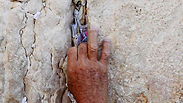
Western Wall cleaned for Passover
Ahead of Jewish holiday, Rabbi Shmuel Rabinowitz and his team clear out thousands of notes placed by worshippers in holy wall's cracks.
Every year, millions of people visit the Western Wall, Judaism's holiest site, leaving written prayers on pieces of paper wedged into the cracks of the ancient stones.
Video courtesy of jn1.tv
"In the past few months, people have been placing their requests from God. We pray so that God may heed their prayers," Rabbi Rabinowitz says. "This is the place where King Solomon asked that every prayer, every request, of every person, 'that he may place his palms at this dwelling', so that God may hear his prayer."
As Western Wall rabbi, Rabinowitz must ensure there is enough room for future prayers, so twice each year his team collects the hundreds of thousands of notes before burying them. Rabinowitz and his team use sticks when extracting the thousands of small notes from the cracks in the wall, preventing any damage to the ancient stones.
"It is written in the Torah not to put iron on the altar, on sacred things," he says. "Iron is something that kills, iron is something that destroys. We use wood that is not something that desecrates. It doesn't hurt, doesn't destroy. That is what they did at the time of the Temple and that is what we do here."
The Western Wall is almost consistently lined with people deep in prayer, many of whom lean forward with their eyes closed, touch their foreheads to the stones and whisper their wishes before kissing the wall when they have finished praying. Leaving notes of prayers and pleads has been adopted by members of many faiths around the world.
"This place is a sacred place to the Jewish people, and the Jewish people's notes. This is the wall of their tears. Generations upon generations had dreamed about reaching this place," Rabbi Rabinowitz says.
The Western Wall is a remnant of the compound of the Second Temple destroyed in 70 AD. Today, it stands beneath a religious plaza known to the Muslims as al-Haram al-Sharif and to Jews as the Temple Mount.










